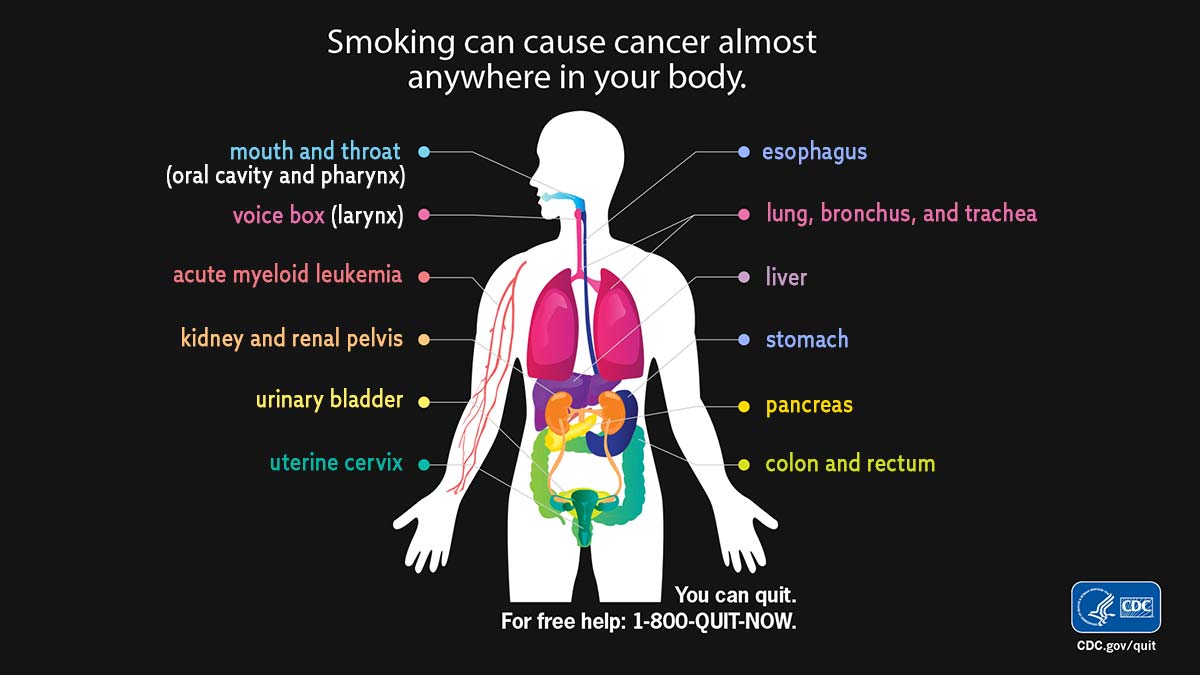At a glance
- Cigarette smoke contains more than 7,000 chemicals. At least 69 of these chemicals can cause cancer.
- Smoking can cause cancer almost anywhere in the body.
- Quitting smoking lowers the risk for 12 different cancers and also benefits people diagnosed with cancer.

Cancer overview
Cancer refers to diseases in which cells divide out of control. These cells can invade or spread to other parts of the body. Cancer cells are spread through the blood and lymph systems, which help the body get rid of toxins. 12
There are more than 100 different types of cancer. Most cancers are named after the organ or type of cell in which they start. For example, lung cancer begins in the lung and laryngeal cancer begins in the larynx (voice box). 1
Smoking and cancer
Cigarette smoke contains more than 7,000 chemicals. At least 69 of these chemicals can cause cancer. Other chemicals can interfere with the body's ability to fight cancer. 3
Smoking can also:
- Weaken the body's immune system. This makes it harder for your body to kill cancer cells. When this happens, cancer cells can grow and spread.
- Damage or change a cell's DNA. When DNA is damaged, a cell can begin growing out of control and create a cancer tumor.
Cigarette smoking causes about one out of every three cancer deaths in the United States. 45 Smoking can cause cancer almost anywhere in your body including in the: 5
- Bladder
- Blood (acute myeloid leukemia)
- Cervix
- Colon and rectum
- Esophagus
- Kidney and renal pelvis
- Larynx (voice box)
- Liver
- Lung, bronchus, and trachea
- Mouth and throat
- Pancreas
- Stomach
Research also suggests that men with prostate cancer who smoke may be more likely to die from prostate cancer than men who do not smoke. 5
Lung cancer is the leading cause of cancer death in men and women in the United States. Cigarette smoking or secondhand smoke exposure cause nearly 9 out of 10 lung cancer deaths. 5 People who smoke increase their risk of developing lung cancer by about 25 times that of people who don’t smoke.5 People who smoke have a greater risk for lung cancer today than they did in 1964, even though they smoke fewer cigarettes. 5 One reason for this may be changes in how cigarettes are made. Another reason may be changes in the chemicals cigarettes contain. 5
The U.S. Preventive Services Task Force (USPSTF) recommends lung cancer screening for some adults with a history of heavy smoking (see "Cancer Screenings" section below for more information).

Smokeless tobacco and cancer
Smokeless tobacco, such as chewing tobacco, also causes cancer, including: 6
Secondhand smoke exposure and cancer
Secondhand smoke is smoke from burning tobacco products, like cigarettes, cigars, hookahs, or pipes. Secondhand smoke exposure occurs when people breathe in smoke from burning tobacco products. Exposure also occurs when people breathe in smoke exhaled by someone who is smoking.
Secondhand smoke can cause lung cancer in people who have never smoked. In the United States, more than 7,300 people die each year from lung cancer caused by secondhand smoke. 57
Smoking and people diagnosed with cancer
Smoking is a serious concern for people with cancer at all stages of disease and treatment, including after treatment ends. Smoking: 5
- Increases the risk of death, including death from cancer.
- Increases the risk for developing other smoking-related cancers.
- May increase risk of cancer recurrence (cancer coming back after treatment).
- May result in poorer response to treatment.
- May result in more treatment complications and side effects.
Quitting smoking can protect people from cancer
Quitting smoking is one of the most important actions people can take to improve their health. This is true for all people who smoke, regardless of their age, how long they have smoked, or how much they smoke. 8
Quitting smoking lowers the risk for 12 different cancers, including cancer of the: 8
- Bladder
- Blood (acute myeloid leukemia)
- Cervix
- Colon and rectum
- Esophagus
- Kidney and renal pelvis
- Larynx
- Liver
- Lung, bronchus, and trachea
- Mouth and throat
- Pancreas
- Stomach
The risk of developing cancer decreases over time: 358
- 5 to 10 years after quitting, added risk of cancers of the larynx, oral cavity and pharynx drops by half.
- 10 years after quitting, risk of cancers of the bladder, esophagus, and kidney decreases.
- 10 to 15 years after quitting, added risk of lung cancer drops by half.
- 20 years after quitting, risk of cancers of the larynx, oral cavity and pharynx, and pancreas drops to close to that of someone who does not smoke.
- 20 years after quitting, added risk of cervical cancer drops by about half.
NOTE: Reduced risk refers to quitting in comparison to continued smoking.
Quitting smoking can also benefit people diagnosed with cancer. Research suggests that people with cancer can reduce their risk of death by quitting smoking. 8 Quitting smoking also improves the prognosis for people with cancer. 58
Cancer screenings
Cancer screening means checking your body for cancer before you have symptoms. It is important to get screening tests on a regular basis. This can help find cancers early when treatment is likely to work best. Screening is available for three of the cancers that can be caused by smoking.
Cervical cancer screening with the HPV test and the Pap test can help prevent cervical cancer or find it early. CDC offers free or low-cost cervical cancer screening nationwide.
Colorectal cancer screening can find precancerous polyps (abnormal growths) so they can be removed before they turn into cancer. Screening tests can also find colorectal cancer early.
Lung cancer screening is recommended by the U.S. Preventive Services Task Force (USPSTF) for some adults with a history of heavy smoking. The only recommended screening test for lung cancer is low-dose computed tomography (also called a low-dose CT scan, or LDCT).
The USPSTF recommends yearly screening for lung cancer with LDCT for people who 9:
- Have a 20 pack-year* or more smoking history, and
- Smoke now or have quit within the past 15 years, and
- Are between 50 and 80 years old.
*A pack-year is smoking an average of one pack of cigarettes per day for one year. For example, a person could have a 20 pack-year history by smoking one pack a day for 20 years. They could also smoke two packs a day for 10 years.
The USPSTF recommends stopping yearly screening if a person:
- Turns 81 or
- Has not smoked for 15 years or
- Develops a health problem that substantially limits the person's life expectancy or
- Develops a health problem that makes the person unwilling or unable to have surgery if lung cancer is found. 9
- National Cancer Institute. What Is Cancer? Accessed March 28, 2024. https://www.cancer.gov/about-cancer/understanding/what-is-cancer
- Centers for Disease Control and Prevention. How to Prevent Cancer or Find It Early. Accessed March 28, 2024. https://www.cdc.gov/cancer/prevention/index.html
- U.S. Dept of Health and Human Services. How Tobacco Smoke Causes Disease: The Biology and Behavioral Basis for Smoking-Attributable Disease: A Report of the Surgeon General. U.S. Dept of Health and Human Services; 2010. Accessed March 28, 2024. https://www.ncbi.nlm.nih.gov/books/NBK53017/
- Henley SJ, Thomas CC, Sharapova SR, et al. Vital Signs: Disparities in Tobacco-Related Cancer Incidence and Mortality — United States, 2004–2013. MMWR Morb Mortal Wkly Rep. 2016;65:1212–1218.
- U.S. Department of Health and Human Services. The Health Consequences of Smoking—50 Years of Progress: A Report of the Surgeon General. U.S. Dept of Health and Human Services; 2014. Accessed March 28, 2024. https://www.ncbi.nlm.nih.gov/books/NBK179276/
- International Agency for Research on Cancer. Smokeless Tobacco and Some Tobacco-Specific N-Nitrosamines. World Health Organization; 2007. Accessed March 28,2024. https://publications.iarc.fr/Book-And-Report-Series/Iarc-Monographs-On-The-Identification-Of-Carcinogenic-Hazards-To-Humans/Smokeless-Tobacco-And-Some-Tobacco-specific-Em-N-Em--Nitrosamines-2007
- U.S. Dept of Health and Human Services. The Health Consequences of Involuntary Exposure to Tobacco Smoke: A Report of the Surgeon General. U.S. Dept of Health and Human Services, 2006. Accessed March 28, 2024. https://stacks.cdc.gov/view/cdc/13252
- U.S. Dept of Health and Human Services. Smoking Cessation: A Report of the Surgeon General. U.S. Dept of Health and Human Services, 2020. Accessed March 28, 2024. https://www.hhs.gov/sites/default/files/2020-cessation-sgr-full-report.pdf
- Centers for Disease Control and Prevention. Who Should be Screened for Lung Cancer? Accessed March 28, 2024. https://www.cdc.gov/lung-cancer/screening/index.html
- Centers for Disease Control and Prevention. Screen for Life: National Colorectal Cancer Action Campaign. Accessed March 28, 2024. https://www.cdc.gov/colorectal-cancer/sfl/index.html.
- U.S. Preventive Services Task Force. Final Recommendation Statement: Lung Cancer: Screening. U.S. Preventive Services Task Force; 2016. Accessed March 28, 2024. https://www.uspreventiveservicestaskforce.org/uspstf/document/RecommendationStatementFinal/lung-cancer-screening
